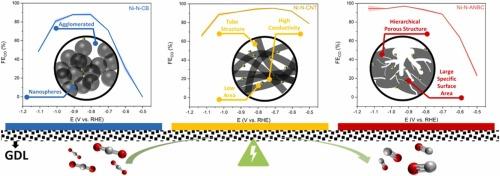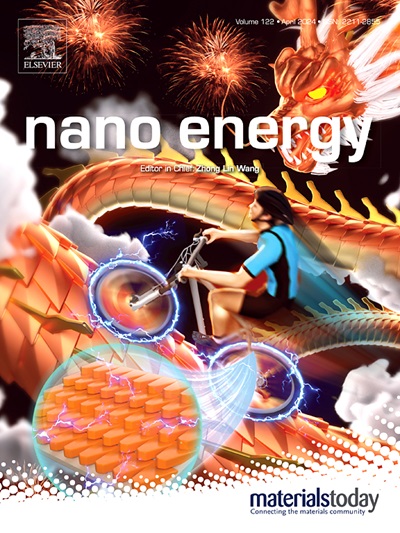碳载体对 Ni-N-C 催化剂将 CO2 还原成 CO 的电催化性能的影响
IF 16.8
1区 材料科学
Q1 CHEMISTRY, PHYSICAL
引用次数: 0
摘要
作为将二氧化碳电还原为一氧化碳的选择性活性催化剂,人们对碳支撑的掺杂镍和氮(Ni-N-C)催化剂进行了广泛的研究。大多数研究侧重于调整镍-氮活性位点的配位结构,而碳支撑的影响往往被忽视。本研究采用配体介导法,在不同的碳载体(包括炭黑(CB)、多壁碳纳米管(CNT)和活性掺氮生物炭(ANBC))上合成了一系列 Ni-N-C 催化剂。在 H 型电池的低电流密度和 MEA 电解槽的高电流密度条件下,研究了碳支持物对二氧化碳还原电催化性能的影响。所有制备的 Ni-N-C 催化剂都显示出良好的 CO 生成法拉第效率 (FE)(高达约 90%),但是 CO 生成的起始电位和部分电流密度差异很大。碳载体的纹理特性和碳载体上 Ni-Nx 活性位点的分布被证明是造成性能差异的主要因素。特别是具有大比表面积的分层多孔结构有助于促进质量传输和改善活性位点的分散,从而使 Ni-N-ANBC 与 Ni-N-CB 和 Ni-N-CNT 相比具有更好的二氧化碳还原性能。这项研究证明了碳载体对 Ni-N-C 催化剂的重要性,并为设计用于 CO2RR 的高效 Ni-N-C 催化剂提供了新的见解。本文章由计算机程序翻译,如有差异,请以英文原文为准。

The effect of carbon supports on the electrocatalytic performance of Ni-N-C catalysts for CO2 reduction to CO
Carbon-supported nickel and nitrogen co-doped (Ni-N-C) catalysts have been extensively studied as selective and active catalysts for CO2 electroreduction to CO. Most studies have focused on adjusting the coordination structure of Ni-Nx active sites, while the impact of the carbon supports has often been overlooked. In this study, a series of Ni-N-C catalysts on different carbon supports, including carbon black (CB), multi-walled carbon nanotubes (CNT), and activated nitrogen-doped biochar (ANBC), were synthesized using a ligand-mediated method. The effect of the carbon support on the electrocatalytic performance for CO2 reduction was investigated at both low current densities, in a H-cell, and high current densities, in a MEA electrolyzer. All of the prepared Ni-N-C catalysts show good faradaic efficiencies (FE) toward CO production (up to ∼90 %), however, the onset potentials and partial current densities for CO production vary greatly. The textural properties of the carbon support and the distribution of Ni-Nx active sites on the carbon support are demonstrated as the main factors behind the performance differences. In particular, hierarchical porous structures with a large specific surface area are helpful to facilitate mass transport and improve the dispersion of active sites, which allows for a better CO2 reduction performance of Ni-N-ANBC compared to Ni-N-CB and Ni-N-CNT. This study demonstrates the importance of the carbon support for Ni-N-C catalysts and provides new insights into the design of efficient Ni-N-C catalysts for the CO2RR.
求助全文
通过发布文献求助,成功后即可免费获取论文全文。
去求助
来源期刊

Nano Energy
CHEMISTRY, PHYSICAL-NANOSCIENCE & NANOTECHNOLOGY
CiteScore
30.30
自引率
7.40%
发文量
1207
审稿时长
23 days
期刊介绍:
Nano Energy is a multidisciplinary, rapid-publication forum of original peer-reviewed contributions on the science and engineering of nanomaterials and nanodevices used in all forms of energy harvesting, conversion, storage, utilization and policy. Through its mixture of articles, reviews, communications, research news, and information on key developments, Nano Energy provides a comprehensive coverage of this exciting and dynamic field which joins nanoscience and nanotechnology with energy science. The journal is relevant to all those who are interested in nanomaterials solutions to the energy problem.
Nano Energy publishes original experimental and theoretical research on all aspects of energy-related research which utilizes nanomaterials and nanotechnology. Manuscripts of four types are considered: review articles which inform readers of the latest research and advances in energy science; rapid communications which feature exciting research breakthroughs in the field; full-length articles which report comprehensive research developments; and news and opinions which comment on topical issues or express views on the developments in related fields.
 求助内容:
求助内容: 应助结果提醒方式:
应助结果提醒方式:


